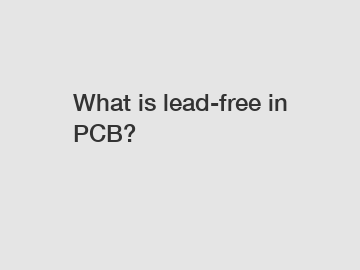What is lead-free in PCB?
If you're in the business of PCB manufacturing, you may have heard about lead-free PCBs. But what exactly does lead-free mean in the context of PCBs? Read on to find out!
What is Lead-Free in PCBs?
Lead-free in PCBs refers to the absence of lead in the manufacturing process. Lead has historically been used in electronics manufacturing due to its low cost and ease of use. However, concerns about the environmental and health impacts of lead have led to a shift towards lead-free alternatives.

Why Go Lead-Free?
Lead is a toxic metal that can have serious health effects, especially on children and pregnant women. By eliminating lead from PCBs, manufacturers can reduce the risk of exposure to harmful substances.
Lead-free PCBs are also more environmentally friendly, as lead can leach into soil and water sources when disposed of improperly. By using lead-free materials, manufacturers can reduce their impact on the environment.
In addition, lead-free PCBs are compliant with regulations such as the Restriction of Hazardous Substances (RoHS) directive, which restricts the use of certain hazardous substances in electronics.
How are Lead-Free PCBs Made?
Lead-free PCBs are typically made using alternative materials such as tin-silver-copper (SAC) or tin-copper (SnCu) alloys. These materials provide similar performance to lead-based solders, but without the negative impacts of lead.
During the manufacturing process, lead-free solder is used to attach components to the PCB. This solder is heated to a specific temperature, allowing it to bond with the metal pads on the PCB. The result is a strong and reliable connection without the use of lead.
Benefits of Lead-Free PCBs.
There are several benefits to using lead-free PCBs. For one, lead-free PCBs are safer for both manufacturing workers and end-users, as they eliminate the risk of lead exposure. This can lead to a healthier work environment and safer products for consumers.
Lead-free PCBs also help manufacturers comply with regulations such as RoHS, which are becoming increasingly important in the electronics industry. By using lead-free materials, manufacturers can ensure that their products meet regulatory requirements and avoid costly fines or penalties.
Additionally, lead-free PCBs are more environmentally friendly, as they reduce the amount of toxic substances released into the environment. This makes lead-free PCBs a more sustainable option for manufacturers looking to minimize their environmental impact.
In conclusion, lead-free PCBs offer a safer, more environmentally friendly alternative to traditional lead-based PCBs. By eliminating lead from the manufacturing process, manufacturers can create products that are safer for both workers and consumers, as well as compliant with regulations. If you're interested in learning more about lead-free PCBs, feel free to contact us for information on our lead-free PCB supplier.
Contact us to discuss your requirements of hasl lead free, Industrial Control PCB Manufacturer, consumer electronics pcb . Our experienced sales team can help you identify the options that best suit your needs.

Comments